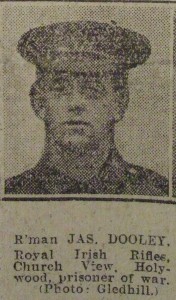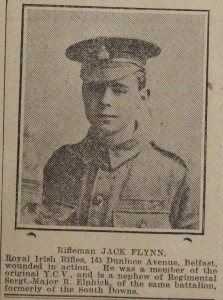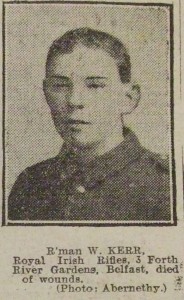
Rifleman James Dooley
The enlistment registers of the 14th (Young Citizen Volunteer) Battalion of the Royal Irish Rifles, shows that despite the loyalist narrative that has sprung up around the 36th Ulster Division, there were a number of men who described themselves as Roman Catholic enlisting in the battalion.
There were at least 88 Roman Catholics with addresses all over Ireland who enlisted in the Young Citizen Volunteer Battalion of the Royal Irish Rifles, of which 42 were from Ulster.
These men included:
- Foundry worker William Kerr from Whiterock who was killed in action aged 22, Alfred Wynne who died aged only 18 from the New Lodge and Robert Dennison of Lisburn who died just 4 weeks before the end of the war.
- Two Roman Catholic RIC Sergeants lost their sons in the war, Crumlin Road Gaelic speaker Charles Blake died aged 24, while East Belfast’s Martin William Jennings died aged 21.
- Roman Catholic brothers who served include the Rooney brothers. Kilkeel born and Short Strand reared, only one would return home; Peter Rooney was killed on the first day of the Somme aged only 20. Widowed mother, Ernestine of Bangor was lucky to have both of her boys Raymond and Ernest Warnock home safe after the war despite one son being wounded.
- James Davey Maxwell’s father was a Scots Presbyterian from Glasgow and his mother an English Catholic from Liverpool. Their Catholic son James was killed in action at The Battle of Langemarck, aged only 20.
- Newly married Gaelic speaker, 18 year old John McKee from Armagh was killed in action in April 1918, his wife Cecelia placing on his gravestone ‘On His Soul Sweet Jesus Have Mercy’.
- Marksman William McGarrell of Dromore died of his wounds aged 21 in the Dressing Station, his body buried in Duhallow Advanced Dressing Station Cemetery.
- Ormeau lad James Magee served till the end of the war, being promoted to Lance Corporal. He was awarded the Victory Medal and the British War Medal, both of which were marked as returned.
- Another Ormeau boy to survive the war was 2nd Lieutenant James Redmond from Kimberly Street who served with both the YCV and the Royal Inniskilling Fusiliers.

Rifleman Jack Flynn
The 36th Ulster Division was made up of 107th, 108th, 109th Brigades, Divisional troops, mounted troops and artillery as well as Royal Engineers, Royal Army Medical Corps and other divisional troops. These Brigades included Royal Irish Rifles, Royal Irish Fusiliers and Royal Inniskilling Fusiliers.
The 14th (YCV) Royal Irish Rifles was formed in Belfast in September 1914 from the Belfast Volunteers and came under orders of 109th Brigade in 36th (Ulster) Division. The battalion moved to Bundoran in December 1914 moving on to Randalstown in January 1915. In July 1915 they were moved to Seaford and in October 1915 they landed at Boulogne. On 18 February 1918 the battalion was disbanded in France and personnel re-allocated to other battalions of Royal Irish Rifles.
The review of the 36th Ulster Division before they embarked for France occurred in May 1915. The Belfast Newsletter of 6th May noted under the headline Young Citizens Arrive in Belfast:

Rifleman William Kerr
“The 14th Battalion Royal Irish Rifles (Young Citizen Volunteers) left camp Randalstown yesterday morning, and marched via Crumlin to Belfast for the purpose of taking part in the review of the Ulster Division on Saturday. The men carried their rifles, packs, and entrenching tools, and notwithstanding the long distance they had covered – 22 miles – they appeared to be in excellent condition as they passed through the centre of the city at six o’clock in the evening on their way to the yard of Messrs. Davidson & Co. Ltd., Mountpottinger Road, where they piled arms and were dismissed.
Lieutenant-Colonel R. P. D. Spencer Chichester, the commanding officer, rode at the head of his men, and the battalion band played appropriate airs. A large number of spectators witnessed the progress of the men through the city. The battalion was accompanied by its cyclist, signalling, and ambulance detachments, as well as by its transport.
This evening the rank and file will be the guests of the officers at the Royal Hippodrome, and at six o’clock tomorrow evening they will attend a meeting in the Ulster Hall. On Sunday they will attend a Divine service in the Ulster Hall at 2:30 p.m., and at noon on Monday they will leave the city on the return march to Randalstown.”
As the Unionist Centenary Committee marks the centenary of the Review of the 36th Ulster Division with a Parade past the City Hall on Saturday 9th May, it must be remembered that the 36th Ulster Division was not only made up of Protestants. People across Ireland enlisted in the war effort for various reasons, and there were at least 88 Roman Catholics with addresses all over Ireland who enlisted in the Young Citizen Volunteers, of which 42 were from Ulster. At least 8 Roman Catholic Ulstermen in the YCV gave their lives with the Ulster Division.
Karen O’Rawe from History Hub Ulster said: “It is important that our commemorative activities acknowledge the true history of the men who served in the 36th (Ulster) Division. The divergence between the real history of the 36th and the single minded commemoration which exists in our communities today needs to be recognised. A wholly unionist Protestant Division marching off to war is an imagined past and History Hub Ulster would like to use the opportunity of the Centenary to extend an invitation for others to tell their stories whether Catholic, Jewish or Quaker, or indeed those from other regions of Ireland and the UK who were drafted into the Ulster Division.”
The 42 men are listed below:
Rifleman William Kerr of Forth River Gardens, Springfield Road, Belfast KIA
Rifleman James Dooley of Church View, Holywood KIA
Rifleman Charles J Blake of Crumlin Road, Belfast KIA
Corporal James Davy Maxwell of 136 Dunluce Avenue, Lisburn Road, Belfast KIA
Rifleman Robert Dennison of 71 Bridge Street, Lisburn KIA
Rifleman Patrick Hughes of Altcar Street, Belfast KIA
Lance Corporal William McGarrell of Lurgan Bane, Dromore KIA
Rifleman Martin William Jennings of 33 London Street, Belfast KIA
Rifleman John Campbell of Knockbarragh, Rostrevor
Rifleman James Magee of 45 Spruce Street, Belfast
Rifleman Alfred Wynne of 84 Lepper Street, Belfast
Rifleman John Flynn of 143 Dunluce Avenue, Belfast
Lance Corporal John McKee of Annacramp, Armagh
Rifleman Francis McNally of 20 Havana Street, Belfast
Lance Corporal John O’Brien of Bailieborough, Cavan
2nd Lieutenant James Redmond of 80 Kimberly Street, Belfast
Rifleman Peter Rooney of 43 Kilmood Street, Belfast
Rifleman Thomas Rooney of 43 Kilmood Street, Belfast
Rifleman Raymond D Warnock of 54 Ballyholme Road, Bangor
Corporal Ernest J Warnock of 54 Ballyholme Road, Bangor
Rifleman H Bryan of 24 Kingston Street, Belfast
Rifleman P Brownlee of 25 Belgrave Street, Belfast
Rifleman F Girvan of 3 Mary Place, Whitehouse, Belfast
Rifleman Thomas Hall of Ballylueas, Downpatrick
Rifleman E Russell of Tullymore, Newcastle
Rifleman W. J. Smith of 105 Albert Street, Belfast
Rifleman T Tumelty of 13 Sheriff Street, Belfast
Rifleman P Vallelly of Stanhope Street, Belfast
Rifleman F Kunan of 148 Ravenhill Road, Belfast
Rifleman William Loughran of 16 Marys Street, Belfast
Rifleman E Robinson of Magheralin, Lurgan
Rifleman P Rodgers of 5 Sunwick Street, Belfast
Rifleman Hugh Magee of Carrycowan, Martinstown
Rifleman J Macklin of 22 Valentine Street, Belfast
Rifleman T Murphy of 17 Parkview Street, Belfast
Rifleman A McVeigh of 28 Croft Road, Carnlough
Rifleman H McNamara of Ballynahinch Street, Hillsborough
Rifleman J McMullen of 23 Sherwood Street, Belfast
Rifleman J McLaughlin of 71 Derwent Street, Belfast
Rifleman E McGreevy of Ballyalton, Downpatrick
Rifleman M Quinn of Levanmore, Newry
Lance Corporal T Dogherty of Sappagh Muff, Donegal
Research: Karen O’Rawe, Chair, History Hub Ulster
Pictures: Nigel Henderson, Member, History Hub Ulster
With thanks to John McCormick
History Hub Ulster is a research group based in Belfast, but working on projects across Ulster
